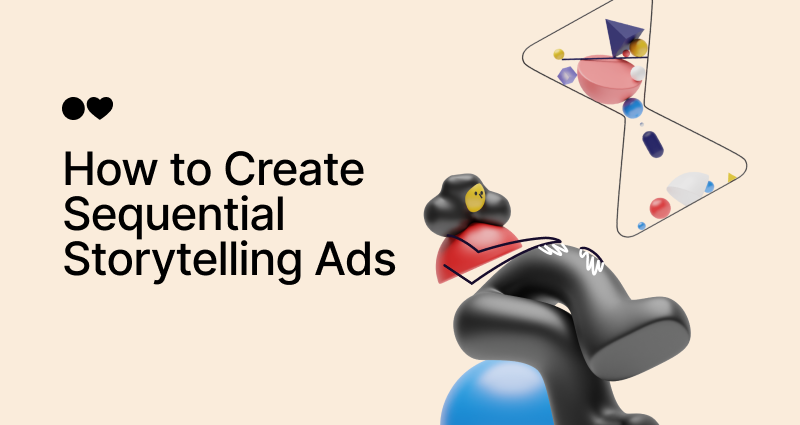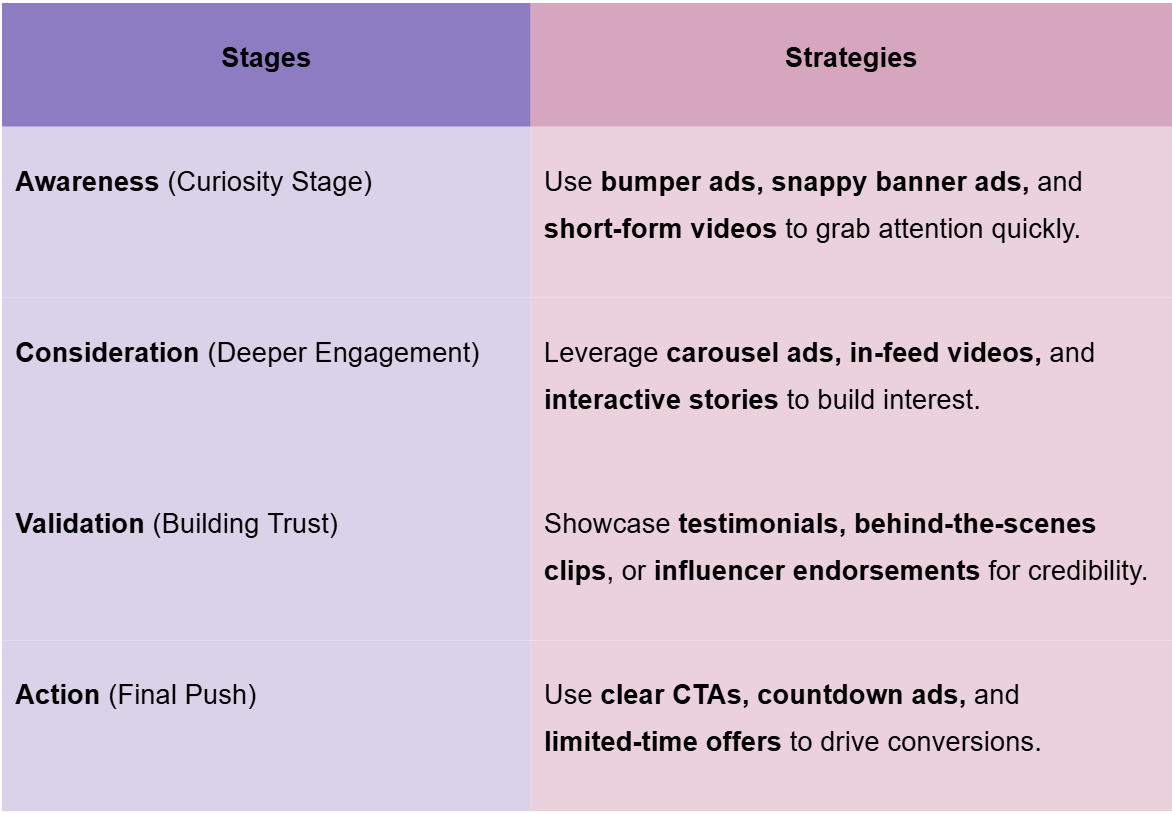Important tool updates - Learn more
- Learn
-
Articles
Read about influencer marketing
-
Growthnotes - Newsletter
Insights for the modern marketer

Storytelling isn't just a creative flex; it makes people stop, listen, and remember. About 15% of them make an instant purchase when a brand's story truly resonates with them.
But let’s be honest: not every brand knows how to pull that off. Some try to tell a story, but it ends up feeling like three random ads stitched together. Others get the narrative right but miss the timing, the structure, or the audience entirely.
That’s where this guide comes in. We’re breaking down how to plan and build sequential storytelling ads that actually convert.
It covers:
P.S. Curious how your sequential ads will look before launch? inBeat.co’s mockup tool helps you visualize your full ad flow, making it easy to spot gaps or refine your message early. Moreover, once live, our free toolkit gives you clear data on CPM, CTA, CTR, and bounce rates so you can track performance across the entire sequence with confidence.
Sequential storytelling breaks a brand message into a series of ads that build on one another—boosting engagement, memorability, and conversions by up to 30%.
Popular storytelling sequences include:
Execution strategy includes:
Key challenges to address:
Emerging trends driving better results:
Pro tip: Tools like inBeat’s ad mockup generator and influencer network help you craft, preview, and refine storytelling ad sequences that resonate and convert.
Sequential storytelling is a marketing approach where you share a story across a series of ads, each building on the last. Instead of dumping everything into a single campaign, it breaks the message into smaller parts.
The first ad might be all about teaser content, just enough to grab attention.
The next? Maybe it goes deeper into the problem you solve. Then comes the big reveal, the solution, and finally, a push toward decisive action.
If you use a clear sequence of ads, you are highly likely to outperform traditional ad campaigns in both reach and results. And the numbers prove that. According to stats, sequential storytelling can boost conversion rates by up to 30%, which has a direct positive impact on ROI.
For PUMA’s campaign, our team at inBeat structured a sequential ad flow using three Instagram Stories and a Reel to guide the audience from awareness to action.
The first story introduced the exclusive discount, using an eye-catching CTA overlay to direct viewers to the main video post. This built initial awareness and encouraged engagement.
The second story showcased the barcode for in-store use, with clear instructions on how to screenshot and redeem it at checkout. This interactive element made the offer feel accessible and exclusive.
The third story reminded viewers that the offer was ending soon, posted strategically to push last-minute action.
The Reel wrapped up the campaign, summarizing the discount details, store locations, and urgency to maximize reach and conversions.
As Forbes highlights:
“Stories are also more memorable than mere facts or statistics. A well-told story can stick in the minds of consumers, making them more likely to remember the brand and its message. Particularly in a crowded market, storytelling can set a brand apart. By sharing unique narratives, brands can highlight their values, mission and the people behind the products, creating a distinct identity.” Maria Alonso, Forbes Councils Member.
Besides being a creative win, the storytelling approach's success is backed by solid numbers.
A study by Ipsos found that running a three-part video sequence led to an 89% lift in key message retention.
Also, 92% of consumers want brands to create story-like ads, which highlights the demand for narrative-driven content.
With the effectiveness of sequential storytelling clear, let’s explore the different types of storytelling sequences you can use. There are different styles of sequential storytelling, each with its own rhythm and purpose.
A three-part sequential storytelling format that starts with intrigue, builds emotional weight, and ends with a strong reminder. It’s perfect for keeping your brand takeaway top of mind and pushing those click-through rates up.
Example: A high-end skincare brand teases a mystery product, reveals benefits in phase two, and then closes with a limited-time offer.
A real example of this strategy in action is KFC Malaysia's campaign to promote their "Super Jimat Box" meal.
1. Tease: KFC initiated the campaign with a short teaser video that introduced the brand and hinted at an upcoming promotion, creating curiosity among viewers.
2. Amplify: Following the teaser, they released a longer, 30-second ad detailing the "Super Jimat Box" meal, showcasing the product and its value proposition to deepen audience engagement.
3. Echo: The campaign concluded with another short ad reinforcing the promotion and encouraging viewers to take action, thereby solidifying the message and prompting conversions.
The brand’s message unfolds over a series of videos in this type, with each part revealing something new. It’s immersive, great for deeper storytelling, and keeps people coming back for the next “episode.”
Example: Nike’s Common Thread series follows real athletes like Ingrid and Alex across multiple episodes while exploring their personal journeys through sport, culture, and identity.
Instead of building a long narrative, it delivers one focused message across two or three fast-hitting ads. The tone stays consistent, and each ad reinforces the same idea from a slightly different angle.
Example: Google’s “Parisian Love” ad is a great example of direct shot storytelling. It tells a full love story using just a sequence of search queries.
Built on sequential retargeting, it uses previous interactions to serve personalized messages that feel more relevant than a cold start. The payoff? Retargeted users are 8x cheaper to reach per click in a sequential advertising campaign.
Example: This Airbnb ad uses a follow-up storytelling sequence by retargeting users with personalized visuals that build on previous interest and guide them toward booking.
This sequence is designed for first-timers, people who’ve never seen your brand before. It starts with soft-touch, scroll-stopping content that builds curiosity. As interest grows, the messaging gets more detailed to guide viewers through the customer journey.
Example: A clean energy startup opens with a bold stat: “One rooftop panel offsets 4 tons of CO₂ a year.” The next ad tells the founder’s story. The final ad? A clean, direct invite to calculate your home’s energy savings and sign up.
After knowing the different types of storytelling sequences, let’s talk about how to actually bring them to life. InBeat experts have shared a step-by-step guide to planning and creating effective sequential storytelling ads.
Every story needs three core elements central figure, a world, and something at stake.
Hero – This could be your customer, product, or brand ambassador. Who is at the center of your narrative?
Setting – Where does this story take place? Think of your audience’s everyday reality; what’s familiar and relatable?
Tension – What challenge or problem does the hero face? This could be confusion, high costs, wasted time, social status, or any pain point that makes your audience stop and pay attention.
💡 Pro tip: The stronger the tension, the more compelling your ad sequence becomes. It creates emotional engagement, making people want to see what happens next.
Your storytelling structure sets the pace for how your audience experiences your message.
Are you:
Also, if you're targeting multiple audience segments, consider building parallel paths with personalized messages. New visitors get the intro, while returning users dive into deeper context.
A good story doesn’t hit all at once. It unfolds. So, the key is to break your messages into phases, like:
Basically, your campaign should evolve, whether it’s through visuals, tone, or message clarity. Without that progression, you’re not telling a story; you’re just running a loop.
This is where the efforts of many brands fall flat. You can’t use the same creative across every social media platform and expect results.
We recommend the following strategies:

In simple words, you have to match the content format to the emotional weight of that moment and the platform’s best practices. What works on TikTok won’t necessarily perform the same on LinkedIn or Facebook.
Remember, influencers aren’t just content creators. They’re storytellers who know what grabs attention in real time.
First, they optimize pacing, knowing exactly when to tease, reveal, and amplify a message to keep viewers hooked throughout the ad sequence.
Their content also carries an authentic tone, which makes the storytelling feel genuine and relatable.
Lastly, influencers have a platform-specific strategy; they understand which content formats perform best on different platforms like TikTok, Instagram, YouTube, and Facebook. This ensures your story is told in a way that resonates with the right audience on each channel.
P.S. Wondering how to find the right influencer? Don’t worry! inBeat Agency hooks you up with micro-influencers in your niche who craft scroll-stopping stories that actually convert.
Before launching your sequential storytelling campaign, preview how the entire story plays out. Platforms like inBeat.co offer free ad mockup generators that let you build mockups across every major social media platform, including:
You can customize everything: images, profile names, ad copy, headlines, and call-to-action buttons like “Learn More,” “Book Now,” “Download,” and more.
What makes these mockups especially useful for storytelling is the ability to test multiple ad formats, including:
This lets you align the creative flow with the platform's native experience while keeping your sequence of ads visually cohesive.
The strength of a sequential ad campaign isn’t measured by how well the first ad performs. It’s about how the whole story moves people.
We advise focusing on metrics that reflect the full journey, like:
And if you are looking for quick answers on ad performance, inBeat.co offers free marketing calculators. They let you instantly measure key metrics like CPA, CPM, bounce rates, and CTR to fine-tune your sequential ad campaign with zero guesswork.
Building a sequential storytelling ad is one part of the process. Keeping it on track without losing impact? That’s where things get tricky with challenges, such as:
Bombarding viewers with the same sequence of ads can lead to disengagement. To maintain viewers' attention, use tools like inBeat.co’s ad mockup generators to test different variations of your sequential messages.
Also, implement frequency capping to control how often users see the same ad. Mix up formats (carousel, video, stories) to keep the campaign fresh and engaging.
When storytelling overshadows the message, the campaign objectives can get diluted, which leads to weaker performance and confused target audiences.
The best approach is to align each phase of the story with a clear business goal, whether it's building awareness, driving consideration, or converting leads.
Also, A/B testing different creatives can help identify which versions effectively balance engagement with conversions.
With so many touch points across a sequence of marketing messages, it’s hard to pinpoint what’s working and what’s not. Metrics can overlap, attribution becomes unclear, and real-time adjustments aren’t always easy.
Using cross-platform analytics tools helps consolidate engagement data from different channels and makes it easier to assess performance. Moreover, monitoring drop-off rates at each stage of the sequence provides insights into where users disengage, allowing for necessary optimizations
So, we’ve talked about the tough parts of pulling off a sequential storytelling campaign. Now, let’s check out the trends that are actually making it way more effective.
Sequential storytelling ads allow you to move beyond single-story campaigns and build real momentum. Whether you’re using a sequential billboard campaign, experimenting with narrative structures, or leveraging content strategy across platforms, the goal is the same. It is to tell a story that keeps people watching and makes it easy to take the next step.
Key Takeaways:
One of the most effective ways to increase the reach of your sequential ad campaigns is by partnering with the right creators. inBeat Agency connects you with highly relevant influencers who speak to your end users organically. We also craft data-backed campaigns to help you build storytelling sequences that drive real results.